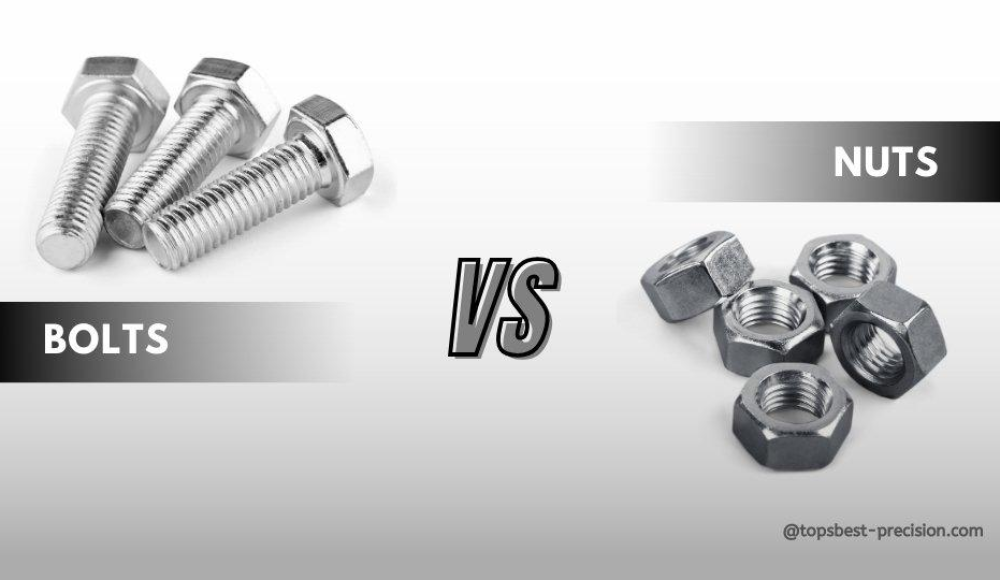Porcas versus parafusos são indispensáveis no automóvel, aeroespacial, mecânico, e indústrias elétricas. Porque, nessas configurações, A proteção do componente é fundamental. Então, Porcas e parafusos fazem esta função de maneira eficaz. Você provavelmente vê porcas e parafusos nas proximidades de tudo. Smartphones, comprimidos, e laptops são alguns dos produtos que usam esses prendedores para ingressar em peças. Além do mais, O fornecimento de produtos como mesas e cadeiras também usam parafusos e parafusos para preservar a integridade estrutural. Neste artigo, Discutiremos diferentes variedades de porcas e parafusos, bem como seu propósito. Além disso, A discussão fará uma comparação dessas peças vitais de fixação.
Para que são usadas porcas para?
Nozes são usadas como fixadores com uma abertura central rosqueada. As roscas de parafuso internas também são conhecidas como roscas de parafuso internas. Isso permite que a porca enfie em um parafuso que tem um fio masculino. Esses componentes são sempre acompanhados de parafusos. A porca junto com o parafuso ajuda a fazer um fecho que une várias partes para facilitar a libertação da conexão, se necessário.
Tipos de nozes
Nozes podem ser classificadas por tamanho, forma, Materiais utilizados, e tipo de thread. O tipo de fixador que está sendo usado em um determinado aplicativo deve ser cuidadosamente escolhido. Por exemplo, Os fixadores de alumínio são conhecidos por serem superiores em condutividade elétrica e térmica; e titânio em peso, corrosão, e força. Nozes hexagonais são o tipo de nozes mais comumente usado em todas as indústrias. No entanto, Há uma vasta lista de tipos de nozes projetados para diferentes fins e circunstâncias.
Nozes de bolota
Nozes de bolota pertencem a nozes. Estes são chamados de bolotas devido à sua forma de noz. Nozes de bolotas são geralmente usadas em decorações. A tampa também protege o final do parafuso e dá uma aparência estética. Adicionalmente, Eles reduzem questões como roupas de roupas em bordas afiadas.
Nozes hexadecrais
O nome (Hexadecimal) vem da estrutura hexagonal de seis lados. Seu design ajuda a reduzir o tempo gasto para as atividades de fixação e desaceleração. Existem várias variações de nozes hexágicas. Cada um tem uma função e benefícios específicos.
- Nozes de acabamento hexadecimal: As porcas de acabamento hexadecimal contêm uma seção transversal circular e fios internos.
- Nozes hexáticas de pequeno padrão: Essas nozes são aplicativos. 20% menos dia em comparação com nozes convencionais. Eles são aplicados principalmente onde as nozes convencionais não podem ser usadas.
- Nozes hexápicas pesadas estruturais: Estes são maiores, e mais profundo em altura, e largura do que as nozes hexadecimais padrão.
Jam nozes
Em geral, Jam nozes são semelhantes aos nozes hexadecimais. Estes geralmente são menores que as nozes padrão, sobre (½ ) do tamanho. Eles são garantidos contra uma noz padrão para evitar desaparafusar. Usar uma porca de geléia é significativa se uma porca normal tende a trabalhar livremente no prisioneiro.
Bloquear porcas
As porcas de trava são altamente resilientes. Eles oferecem grande prevenção contra vibrações desnecessárias e torque. Existem certos tipos e todos eles usam diferentes maneiras de impedir que se tornem soltas. Exemplos notáveis incluem:
- Nozes de trava do castelo: Eles têm slots, e ajudar a proteger componentes. Eles são comuns em automóveis para rodas e rolamentos.
- Nylon inserir nozes: Como o nome sugere, Uma camada de nylon é incorporada no encadeamento. Ajuda na prevenção de vibrações e tem uma capacidade firme de retenção.
- Porcas de trava de torque predominante: Nozes de fontes, é outro nome para as porcas de trava de torque predominante. Eles têm um top cônico que é usado para contorcer forças de travamento.
- Porcas de trava de flange serrilhadas: Essas nozes seguram flanges serrilhadas. Eles exploram as serrilhas para mitigar desfeitos.
Empurre porcas
As porcas são instaladas simplesmente empurrando -as para um eixo. Sua facilidade de aplicação contribui para sua popularidade. No entanto, Eles são difíceis de eliminar devido à sua construção. Push Nuts pode ser usado em uma ampla variedade de produtos médicos, e brinquedos.
Nozes de acoplamento
Nozes de bloqueio de auto-bloqueio são diferentes das nozes comuns. Eles são usados entre dois acessórios com fios masculinos externos. As porcas de acoplamento também são identificadas por nomes como extensão ou porcas de acoplamento de haste. Eles são usados com mais eficiência ao ingressar em hastes ou tubos roscados.
Nozes quadradas
As nozes quadradas dão mais área de superfície de contato para as nozes e, portanto, faça uma conexão mais segura. Sua forma minimiza as chances de giro, e escorregando. Portanto, Estes são adequados para serem usados com parafusos de cabeça quadrada.
T-Nuts
Nutas t ou tee-nozes têm a aparência da letra 't'. Eles têm flanges pilotos. Essas pontas são rosqueadas e parafusadas em materiais, tornando a porca mais ideal para a fixação. Eles são empregados principalmente na fixação de madeira ou peças de plástico.
UNUTS U.
As uas U apresentam uma forma distinta, semelhante a um "U." Eles também são conhecidos como pináculos ou chaminés, refletindo esse design. Eles permitem aos usuários aplicá -los sem exigir ferramentas especializadas. Portanto, Eles são aplicáveis principalmente para conectar folhas de material.
Nozes da asa
As nozes da asa são aquelas que compreendem asas de ambos os lados para serem apertadas e afrouxadas à mão. Eles são flexíveis e adequados para serem usados em áreas onde costumam ser deslocadas.
O que são os parafusos usados para?
Um parafuso é um forte fixador cilíndrico. Possui dois componentes primários: uma haste, e uma cabeça. Geralmente, As cabeças dos parafusos têm um top hexagonal, Enquanto o eixo é uma extensão cilíndrica lisa com uma porção rosqueada. Parafusos desempenham certas funções, como:
- Proteger componentes: A conexão de hardware é feita colocando um parafuso através de um orifício e depois estragando uma porca sobre ele. Os fios no exterior da porca devem se encaixar no interior do outro e não devem soltar.
- Estresse e falha: Os parafusos são submetidos a forças de tração e, embora permaneçam tensões de tração alta
- Exemplos de aplicação: Os parafusos de alternância são adequados para prateleiras ou imagens penduradas em paredes secas. Por outro lado, Os parafusos da máquina são ideais para fixar duas interfaces de metal de uma estrutura.
Variedades de parafusos
Todos os parafusos têm fios externos; no entanto, a aparência deles e a operação são bem diferentes. Existem diferentes parafusos para vários usos em particular.
Parafusos de transporte
Os parafusos de carruagem são parafusos redondos com a cabeça abobadada. Eles são auto-bloqueadores. Esses parafusos têm uma parte quadrada abaixo da cabeça. Isso aparafusa em uma abertura quadrada correspondente para minimizar o movimento quando a porca é apertada ou solta.
Parafusos de âncora
Um parafuso de âncora combina uma haste rosqueada cilíndrica e uma âncora incorporada. A âncora mantém o material firmemente na parede, Enquanto a haste rosqueada se projeta para fora. Esses parafusos são adequados principalmente para serem usados em estruturas de concreto e, como tal, são bem apreciados por contratados e manuais.
Parafusos cegos
Os parafusos cegos são projetados para uso onde o acesso é possível apenas de um lado. Eles oferecem boas forças de aperto e são ideais onde os parafusos normais não podem ser aplicados. Eles são especialmente úteis em instalações de construção e acesso restrito devido à sua instalação simples.
Parafusos de ponta dupla
Parafusos de ponta dupla ou parafusos têm fios nas duas extremidades do parafuso. Eles também contêm eixos cilíndricos no meio. Esses parafusos possuem uma cabeça e são empregados para prender duas partes em muitos setores, como automóvel e construção.
Parafusos hexadecimais
Parafusos hexáticos ou parafusos hexáticos, são prendedores, tem cabeças hexagonais. A parte cilíndrica pode ser totalmente ou parcialmente rosqueada. Esses parafusos são do tipo mais comum e são usados em várias áreas de aplicação em diferentes indústrias.
Parafusos de flange
Os parafusos de flange têm um flange logo abaixo da cabeça do parafuso e agem como uma lavadora. Este flange aprimora o contato da área, Fornecendo um nivelamento da carga de fixação para dar segurança à conexão. Seus usos são bem vistos no encanamento, Indústrias automotivas, bem como indústrias mecânicas.
U-Bolts
Os parafusos em U são em forma de U com extremidades rosqueadas com seções transversais de meia rodada ou retangular. São tipos típicos de prendedores que encontram aplicação em uma ampla gama de indústrias, incluindo indústrias de encanamento e automóveis.
J-Bolts
J-Bolts, ou parafusos de gancho, são conhecidos por sua forma de J. Esses parafusos oferecem forte fixação, conforme usado em projetos de construção, como cobertura e fixação de concreto.
Parafusos de atraso
Os parafusos de atraso são muito fortes e são recomendados para uso ao ingressar em itens grandes e massivos em um projeto. Estes são designs duráveis para uso em aplicações difíceis de fixação.
Parafusos especiais
Parafusos especiais podem ser adquiridos mediante solicitação. Você pode solicitar fornecedores para especificações personalizadas ao comprar esses parafusos. Por exemplo, diâmetro específico, cabeça, e tamanho da linha. Por tal motivo, Parafusos especiais tendem a superar as contrapartes padrão.
Diferenças básicas entre porcas e parafusos
A tabela abaixo é uma tabulação de dissimilaridades entre porcas e parafusos:
| Nozes | Parafusos |
| Nozes têm centros roscados e formas cilíndricas ocas. | Os parafusos contêm uma cabeça e um eixo rosqueado cilíndrico. |
| Implica tópicos internos, comumente referido como fios femininos. | Os parafusos possuem fios masculinos ou externos. |
| Nozes suportam principalmente forças compressivas, que pode levar ao fracasso. | Parafusos exibem forças de tração. Eles podem levar ao fracasso sobre o estresse excessivo. |
| Tipos comuns de nozes incluem hexadecipal, acoplamento, flange, cap, quadrado, fenda, Lock de geléia, asa, empurrar, T-Nuts, e u nozes. | Vários tipos de parafusos incluem flange, olho, cabide, transporte, ombro, âncora, hexadecimal, alternar, atraso, e parafusos da máquina. |
| Geralmente, nozes são menores em tamanho. | Os parafusos são tipicamente maiores em comparação. |
Seleção da porca direita para o seu parafuso
Parafuso e forma de parafuso é cilíndrico e os dois componentes se juntam na face rosqueada. Nesses tópicos, O plano de cisalhamento pode causar falha no material. Em outras palavras, O número de títulos denota a força de um link como o petróleo do fluxo.
A porca e o parafuso devem ser feitos da mesma liga. Além disso, A porca tem pelo menos força igual ao parafuso referente à sua força de tração máxima. Em aplicações críticas de segurança, é recomendável usar uma porca mais forte do que um parafuso. De acordo com os padrões da IFI, A resistência à tração de uma noz deve ser 20% maior que a resistência à tração do parafuso.
Conclusão
Porcas e parafusos geralmente criam confusão na terminologia. Muitas pessoas lutam para usar esses termos com precisão. Os nomes próprios sempre devem ser usados o tempo todo. Este é especialmente o caso ao lidar com a equipe, pedidos de produtos, ou quando em uma loja de ferragens comprando commodities. Parafusos são outro tipo de fixador sobre o qual há pouca confusão, embora tenha um uso claramente definido. Porcas e parafusos, embora sejam dispositivos de fixação empregados simultaneamente, Há uma diferença entre os dois que devem ser entendidos. Se você tiver alguma dúvida, Por favor, não hesite em Entre em contato conosco!




3 pensamentos "Porcas vs parafusos: Seus tipos e diferenças”